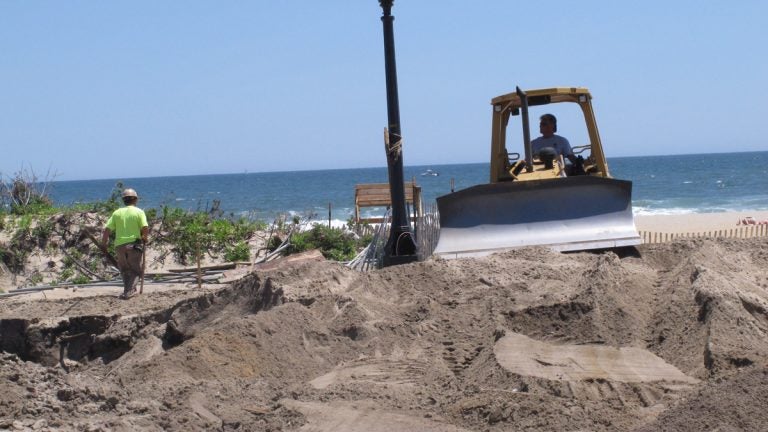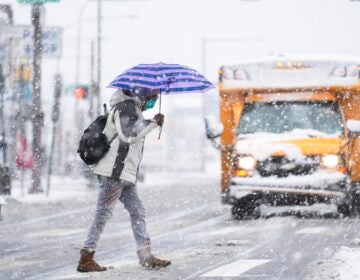10 ways Sandy’s impact continues to be felt in New Jersey

The boardwalk in Ocean Grove N.J. is being rebuilt this month. It was damaged during Sandy. (AP Photo/Wayne Parry)
Kids are getting out of school, the weather is getting nicer, and many people are starting to flock to the Shore as they do each year around this time. Early indicators like pre-season beach tag sales and vacation rental bookings seem to point to a busy summer ahead, at least in some towns.
But residents and long-time visitors say many aspects of coastal life still aren’t the way they were before the storm – and may, in fact, never be the same.
With help from our friends at Jersey Shore Hurricane News, we recently asked readers and Shore residents to tell us what’s changed the most. Here are some of the most notable responses.
Sandy was an unprecedented disaster for New Jersey, so this list is by no means inclusive. If we left something out, feel free to tell us about it and share your story in the comments section.
1. Some places no longer existSandy wiped many familiar places completely off the map. Though many have since been rebuilt, others – like the Long Branch boardwalk – are still not completely ready in time for this summer.
And it’s not just landmarks that disappeared. It might be a favorite store or restaurant, or a familiar seaside path.
In some communities where residents accepted buyouts, entire neighborhoods are being bulldozed. In other places where residents opted to stay put, federal flood maps are forcing them to elevate their homes and rebuild in a more resilient manner.
That will help them withstand future severe storms, but it’s also bittersweet for long-time residents and visitors sentimental for the traditional Jersey Shore bungalow.
2. Neighborhoods are still strugglingSome neighborhoods remain virtual ghost towns, with former residents now living inland while they continue to await funds to repair their damages.
“My waterfront Berkeley Township street is a ragged collection of patches and potholes now,” said one reader who responded to our survey.
Another resident described being “literally overcome with sadness” while traveling along a once-familiar street that doesn’t look the same “or even smell the way it used to.”
3. Going to the beach will never be the sameMany people in New Jersey, New York and Philadelphia grew up spending summers at the Jersey Shore. It was a fun place, filled with good memories, but Sandy changed all that.
“Every time I drive down Rt. 35 I feel the anxiety and sadness that the storm brought,” one Sandy victim wrote.
And another reader, whose parents lost their retirement home in Brigantine, bemoaned the loss of place that had been a gathering place for four generations of her family.
4. Fear is in the airWhile some residents think of Sandy as a once-in-a-lifetime event, many others are worried about what the future may bring. Given the warnings that storms like this could become more frequent and more severe, some fear that they might spend thousands of dollars on repairs, only to have to do it again later.
“This is a haunted area,” commented one reader. “Time has not begun to heal these wounds.”
5. Daily routines have changedAfter an event like Sandy upends your life, it’s sometimes the smaller changes to which it’s most difficult to adjust, the habits and routines you probably didn’t even think about but now find yourself missing.
“It’s getting hard to remember what life was like…,” said one resident. “What has changed? Absolutely everything in our worlds.”
6. Prices Have Gone UpAnother change: The Jersey Shore has become a more expensive place to live.
Housing groups cite the shortage of affordable rental housing. There are anecdotal accounts of contractors engaged in price-gouging.
In addition, new FEMA flood maps are leading to increases in flood-insurance rates for some homeowners It’s not necessarily a direct result of Sandy, but it’s still problematic for many residents because it’s coinciding with what’s already been a difficult recovery.
7. Life is filled with uncertaintyIt’s been more than a year-and-a-half since the storm, but much remains up in the air.
For storm victims still displaced from their homes, it’s hard to make long-term plans without knowing if and when they will get the aid they so desperately need.
Some are dealing with this added worry: Another hurricane season has arrived, but the newly rebuilt dunes many communities were promised continue to be delayed by 600 to 700 property owners who still refuse to sign easements.
One Shore resident commented that “the waiting, the stress, the sleepless nights, the full-time job of phone calls and following up, is literally destroying people.”
8. Frustration and distrust of governmentA Monmouth University/Asbury Park Press poll conducted in April found that public satisfaction with New Jersey’s recovery efforts has dropped below 50 percent, with nearly three quarters of respondents blaming state mismanagement for problems and delays.
“The Christie administration has consistently screwed up in distributing funds through grants and loans,” said Lisa Bogart, whose family’s second home in Toms River’s Bay Shore/Breezy Point section will cost over $100,000 to repair.
“I think our faith in consistent, fair help from state and federal sources has been deeply shaken,” she added,” while praising the work of authorities on the county and municipal level.
Others felt local officials shared in the blame. There’s a feeling that officials at all levels of government are too quick to point the finger rather than accept responsibility for kinks in the recovery process. Whoever’s to blame, lamented another resident, “Millions of dollars raised and earmarked for the Sandy recovery are still stockpiled in accounts out of our reach.”
9. Financial reverberationsWith insurance and aid dollars covering only a portion of their costs, many Shore homeowners have had to dip into their personal savings to get back on their feet. In addition to repair costs, those whose homes were destroyed and who didn’t have friends or family to stay with have had to pay rent somewhere else while continuing to pay mortgages and property taxes on their old homes.
Sandy also destroyed or impacted many businesses, which affected people’s jobs and livelihoods.
10. Renewed appreciation for lifeBut many people are doing their best to look on the bright side of life.
“We are thankful for a lot of things: the fact that no one was physically hurt, our wonderful community and all they’ve done for us, and having a roof over our heads,” said one displaced resident.
“We will be okay!” said another person. “Life is definitely different, but I still have my family and friends that I can relax with, have a glass of wine with and laugh with.”
WHYY is your source for fact-based, in-depth journalism and information. As a nonprofit organization, we rely on financial support from readers like you. Please give today.




